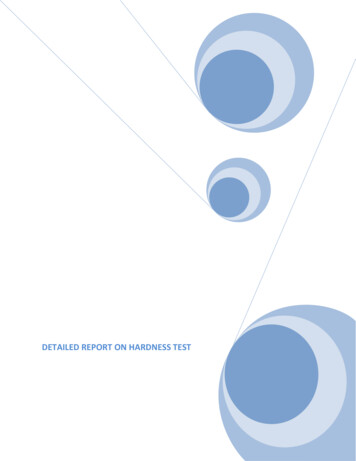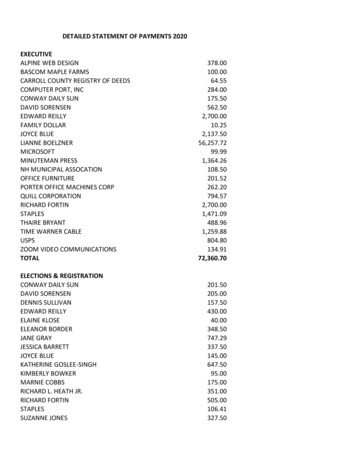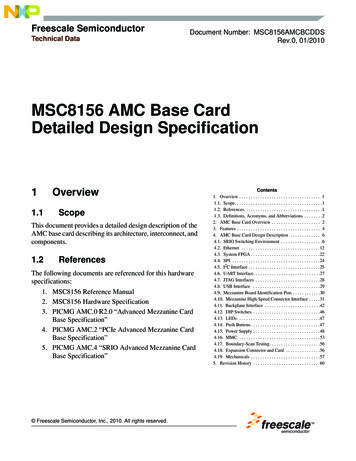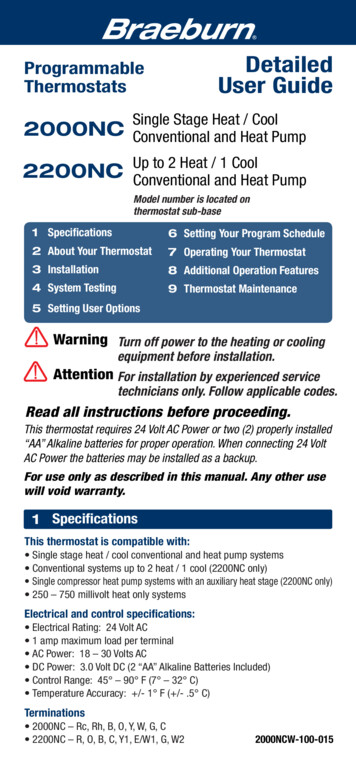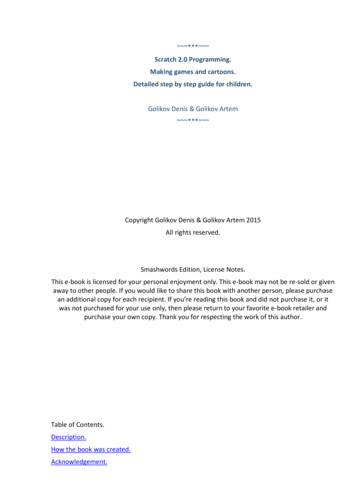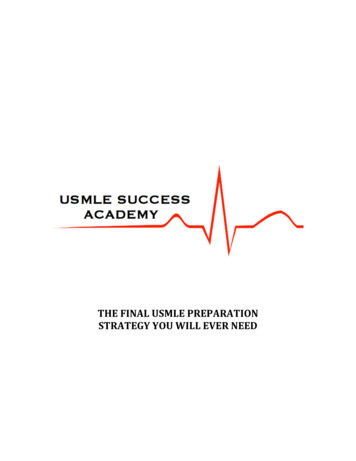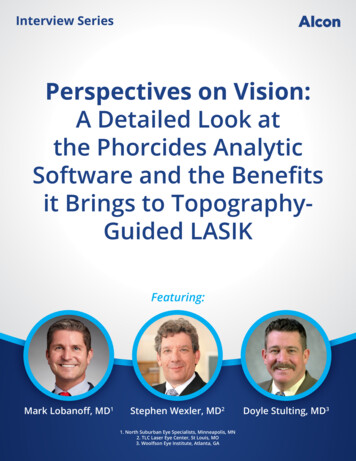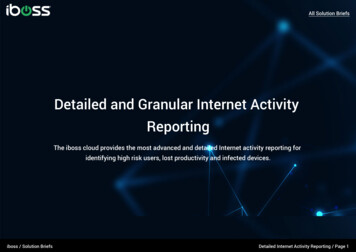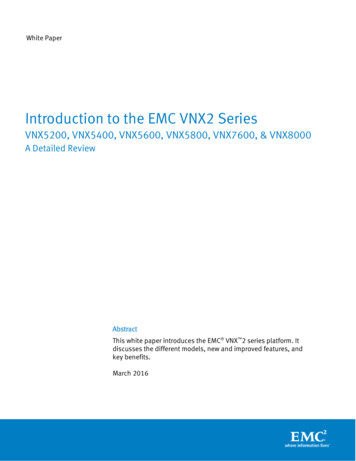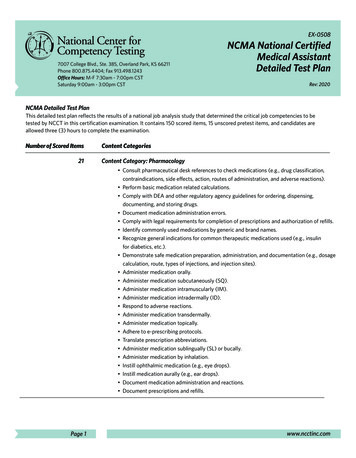
Transcription
EX-05087007 College Blvd., Ste. 385, Overland Park, KS 66211Phone 800.875.4404; Fax 913.498.1243Office Hours: M-F 7:30am - 7:00pm CSTSaturday 9:00am - 3:00pm CSTNCMA National CertifiedMedical AssistantDetailed Test PlanRev: 2020NCMA Detailed Test PlanThis detailed test plan reflects the results of a national job analysis study that determined the critical job competencies to betested by NCCT in this certification examination. It contains 150 scored items, 15 unscored pretest items, and candidates areallowed three (3) hours to complete the examination.Number of Scored Items21Content CategoriesContent Category: Pharmacology Consult pharmaceutical desk references to check medications (e.g., drug classification,contraindications, side effects, action, routes of administration, and adverse reactions). Perform basic medication related calculations. Comply with DEA and other regulatory agency guidelines for ordering, dispensing,documenting, and storing drugs. Document medication administration errors. Comply with legal requirements for completion of prescriptions and authorization of refills. Identify commonly used medications by generic and brand names. Recognize general indications for common therapeutic medications used (e.g., insulinfor diabetics, etc.). Demonstrate safe medication preparation, administration, and documentation (e.g., dosagecalculation, route, types of injections, and injection sites). Administer medication orally. Administer medication subcutaneously (SQ). Administer medication intramuscularly (IM). Administer medication intradermally (ID). Respond to adverse reactions. Administer medication transdermally. Administer medication topically. Adhere to e-prescribing protocols. Translate prescription abbreviations. Administer medication sublingually (SL) or bucally. Administer medication by inhalation. Instill ophthalmic medication (e.g., eye drops). Instill medication aurally (e.g., ear drops). Document medication administration and reactions. Document prescriptions and refills.Page 1www.ncctinc.com
www.ncctinc.comPage 228Content Category: Clinical Medical ProceduresSubcategory: Infection, Exposure Control, and Safety Follow CDC Standard Precautions and transmission precautions (e.g.,airborne, contact,droplet, hand hygiene). Comply with OSHA standards for Health Care Workers (e.g., blood borne pathogens, SDS,needlesticks, bodily fluids). Perform general medical asepsis. Perform surgical asepsis. Implement cleansing, disinfection, and sterilization as needed. Handle and dispose of biohazardous waste. Handle and dispose of chemicals. Use personal protective equipment (e.g., gloves, gown, mask). Follow patient isolation procedures (e.g., radiation, reverse, TB). Respond to emergency situations (e.g., fire, biological hazard). Prevent the spread of healthcare acquired (nosocomial) infection. Practice safety procedures when using medical equipment and supplies (e.g., lock wheels,gait/transfer belts). Transfer patients using correct body mechanics. Activate safety mechanisms for sharps.Subcategory: Patient Care Perform adult and pediatric height, weight, and BMI measurements (e.g., standing,wheelchair). Obtain patient vital signs. Take a patient history. Use a pain scale to report patient pain levels. Position a patient for an exam or procedure (e.g., Fowler’s, lithotomy). Perform a pulse oximetry measurement. Perform vision screening tests (e.g., Snellen, Ishihara, Pelli-Robson). Perform allergy testing. Perform suture and staple removal. Perform auditory acuity tests. Perform ear irrigation. Perform eye irrigation. Assist the provider with patient examinations (e.g., physical, gynecological). Recognize and appropriately report abnormal measure/screening results (e.g., painassessment and monitoring). Prepare and manage patient exam/treatment areas.Adapt care to patients with special needs (e.g., physically, mentally impaired).Perform wound care and/or dressing changes.Assist with immobility support/splint applications (e.g., elastic bandage, wrist splint).Assist with minor surgical procedures (e.g., skin prep).Perform therapeutic modalities as instructed (e.g., crutch training, hot/cold compress,ROM exercises). Provide basic patient instruction/education (hemoccult, breast/testicular self-exams,nutrition). Assist with oxygen therapy (e.g., nasal cannula).
www.ncctinc.comPage 3 21Assist patients with spirometry (e.g., peak flow, PFT).Assist with patient-administered nebulizer treatments.Assist patients with orthotic or prosthetic devices.Perform first aid, BLS, and rapid response procedures.Content Category: Phlebotomy Adhere to standards for patient introduction, identification, and order verification.Evaluate pre-test conditions for patient prior to collection (e.g., fasting, medications).Adhere to patient safety, infection control, and aseptic technique standards.Select appropriate venipuncture equipment for the test ordered and type/age of patient.Prepare the patient and the selected site for blood collection (e.g., micro-sampling,venipuncture, bacterial culture). Select appropriate capillary puncture equipment for the test ordered and type/age of patient. Take appropriate action when blood return is not established (e.g., collapsed vein, missedvein). Follow the correct order of draw for blood samples (e.g., capillary, venous). Identify additives in evacuated blood collection tubes. Follow the manufacturer recommendations for fill level/ratio and tube inversion. Implement precautions for patients with special needs (e.g., mastectomy, IV, burns,dementia, bleeding disorders, other). Perform venipuncture on patients of all ages. Perform capillary punctures by fingerstick. Perform capillary punctures by heelstick. Select appropriate bandaging supplies (e.g., age, allergy, skin type). Perform phlebotomy aftercare. Recognize and respond to complications (e.g., hematoma, excessive bleeding, other). Anticipate pre-analytical errors and complications (e.g., inadequate collection amount,wrong order of draw). Take corrective actions for problems with test requests, specimen transport, or specimenprocessing. Perform blood culture collections. Handle laboratory specimens per protocol (e.g., preservatives, light sensitivity,temperature). Label specimens appropriately. Take appropriate actions for misidentified patients or samples. Process specimens for the laboratory appropriately (e.g., centrifuge, aliquot, storage). Perform special collections (e.g., trace elements, newborn screen, chain of custody).18Content Category: ECG and Other Diagnostic Tests Subcategory: Other Diagnostic Tests Perform CLIA waived point of care testing (POCT) (e.g., urinalysis dip stick, hemoglobinand hematocrit, coagulation, glucose, pregnancy test, fecal occult blood). Perform chain of custody collections (e.g., urine drug screening, paternity testing). Perform lab instrument maintenance and calibration. Collect specimen cultures (e.g., wound, sputum, viral, stool, throat). Instruct patients in specimen collection (e.g., 24-hour urine, clean catch, stool, sputum). Process specimen collections accurately. Perform and record quality control, procedures for CLIA waived point of care testing.
www.ncctinc.comPage 4 Subcategory: ECG Placement Techniques Prepare and position the patient for ECG testing (e.g., gowning, skin preparation). Place electrodes on the patient appropriately for the test (e.g., stress, Holter, telemetry). Use additional resources as needed for specific diagnostic tests (e.g., blood pressure cuff,treadmill, Holter monitor). Adapt technique to patients with special considerations (e.g., amputee, right sided heart,pacemaker). Adapt technique for special populations (e.g., age appropriate, isolation, special needs). Explain the ECG procedure to the patient (e.g., movement, talking, electronics). Provide patient instruction regarding the Holter monitor.Subcategory: ECG Recording Provide ongoing monitoring of the patient during stress testing.Capture and record ECG tracings on a patient.Distinguish between regular and irregular rhythms.Initiate response to life threatening arrhythmias per protocol.Monitor patient vital signs and tolerance during testing.Prepare the report for the physician.Transmit the report to the patient’s EMR/EHR or chart. Subcategory: ECG Troubleshooting and Maintenance Identify recording errors (e.g., improper tracing, standardization mark out of range,improper lead placement). Identify causes of artifact (e.g., somatic tremor, patient movement, wandering baseline,AC interference, seizures). Account for patients with special considerations (e.g., shunts, piercings, scars,pacemaker/AICD-failure to pace). Correct artifacts and recording errors (e.g., paper placement, lead reversal, power loss,remove electronic devices, calm the patient). Ensure proper grounding of the ECG machine. Check battery charge and paper supply. Clean and store the ECG machine after use.21Content Category: General Office Procedures Subcategory: Communication Communicate effectively verbally and in writing. Direct patients and visitors to the appropriate team member or location (e.g., greet,screen, prioritize). Answer, evaluate, and direct incoming calls to team members using effective telephonetechniques. Describe the policies and procedures of the practice to patients. Address possible telephone emergencies appropriately. Initiate the emergency response system (e.g., violent person in the office, fire). Route or transmit medical office correspondence to the appropriate team member viamail, fax or email. Proofread and/or edit office correspondence. Process medical office mail and correspondence via the appropriate shipper andpostage classification (e.g., incoming, outgoing). Ensure the availability of patient informational materials (e.g., pamphlets, patienteducation brochures).
www.ncctinc.comPage 5 Subcategory: Medical Office Computer Applications Maintain the integrity and confidentiality of computer-stored information. Maintain electronic medical office data (e.g., data entry, retrieval, backup). Use standard office software (e.g., word processing, spreadsheet, database, email,internet browsers, presentation graphics applications). Use medical office software applications (e.g., billing, scheduling, electronic medicalrecords, electronic health records, financial). Perform basic operator level troubleshooting on medical office computer equipmentand software. Manage medical office electronic data using devices other than computers (e.g., tablets,mobile phones, bar code scanners, card readers/scanners, kiosks). Use peripheral devices (e.g., printers, copiers, scanners, fax, digital cameras).Subcategory: Scheduling Matrix healthcare schedules (e.g., facility, resources, providers). Set up patient and visitor appointments using standard scheduling techniques (e.g.,modified wave, double booking). Set up patient appointments using telemedicine and/or home monitoring. Manage appointment dates and times with scheduled patients (e.g., confirm, cancel,reschedule, missed appointments). Maintain daily appointment schedules with team members. Generate daily encounter forms for scheduled patients. Manage referrals (e.g., schedule, obtain, verify). Schedule patients for hospital admissions and surgery. Schedule patients for out-patient diagnostic tests and procedures. Manage the patient reminder system (e.g., tickler, recall).Subcategory: Medical Records Require all patients to complete and/or update necessary paperwork/forms.Copy/scan picture identification and insurance card and obtain required signatures.Enter patient information into the medical record.Maintain confidentiality of medical records (e.g., HIPAA compliance).Recognize the stages of meaningful use and merit-based payment (e.g., MIPS).Manage documents and patient charts using paper methods.Manage documents and patient charts using computerized/electronic methods.Respond to legal requests/subpoenas for medical records (e.g., release requests, filetransfers).Respond to patient requests for medical records.Make corrections and additions to medical records per state and federal guidelines.Protect and retain medical records per state and federal guidelines.Move medical records between active, inactive, and closed status.Prepare charts for audits and external reviews.
www.ncctinc.comPage 625Content Category: Medical Office ManagementSubcategory: Medical Office General Management Open and close the medical office for the day. Handle relationships with associated health care provider offices or businessassociates. Comply with accreditation and licensure requirements. Maintain files on the providers’ professional status (e.g., licensure or certification,continuing educational requirements, renewal dates, fees and dues). Maintain the office manuals (e.g., policy and procedures, medical office safety, SDS). Comply with Occupational Safety and Health Act (OSHA) guidelines and regulations. Comply with the Clinical Laboratory Improvement Act (CLIA) guidelines and regulations.Subcategory: Office Financial Management, Billing, Insurance Explain the financial policies and procedures of the practice to patients and/orresponsible parties. Collect payment, copayment, coinsurance, or deductible owed by the patient at thetime of service. Provide fee schedules for the patients. Use Current Procedural Terminology (CPT) and Health Care Financing AdministrationCommon Procedure Coding System (HCPCS) codes to bill for services. Use International Classification of Diseases (ICD) codes to bill for services. Comply with fraud and abuse regulations related to insurance and billing. Manage pre-authorizations, pre-certifications, and pre-determinations (e.g., prepare.,obtain, verify).16Content Category: Law and Ethics Recognize legal responsibilities and the scope of practice for the medical assistant. Recognize unethical practices and respond in an ethical manner for situations in themedical office. Recognize and respond to violations of medical law. Follow the protocol on terminating patient care (e.g., non-compliance, collections). Comply with disclosure laws (e.g., HIPAA, HITECH). Obtain patient consent for examinations and treatment. Adhere to laws regarding reportable incidents and communicable diseases. Advocate for the patient (e.g., patient navigator). Adhere to A Patient’s Bill of Rights (AHA). Adhere to advanced directives (e.g., power of attorney, living will, donor preferences).
www.ncctinc.comPage 7Essential Knowledge Base:Apply a working understanding of these integrated concepts: Medical Law and ethicsSterilization techniquesPatient assessment and vital signsSpecialty examination preparation and assistance (e.g., eye, ear, pediatric, geriatric, reproductive,G/U, ECG)Minor procedure assistance (e.g., surgical)Infection control (e.g., PPE, Biomedical Waste Handling)Anatomy, Physiology, Pathophysiology, and DisordersPreanalytical errors (e.g., hemolysis, hemoconcentration, air in the cuevette)Specimen collecting, handling, and transporting (e.g., blood, urine, cultures)Venipuncture techniquesPatient educationQuality assurancePatient safety and first aidHealthcare regulation (e.g., OSHA, CLIA, CDC, HIPAA, Patient’s Bill of Rights)Chain of custodyCustomer service, complaint resolution, (e.g., de-escalation technique)Medical equipment quality control, operation, and maintenanceMedical historyPharmacology (e.g., administration, interactions, dosages, properties)Medical practice softwareAdministrative procedures (e.g., registration, payment, insurance, financial, mail processing)Emergency preparednessMedical terminology/abbreviationsTherapeutic modalities (e.g., wound care, suture removal, crutch training, splinting, bandaging)
Medical Assistant Detailed Test Plan EX-0508 Consult pharmaceutical desk references to check medications (e.g., drug classification, contraindications, side effects, action, routes of administration, and adverse rea
